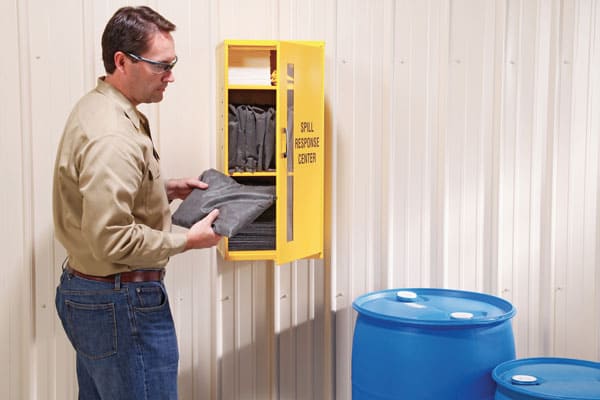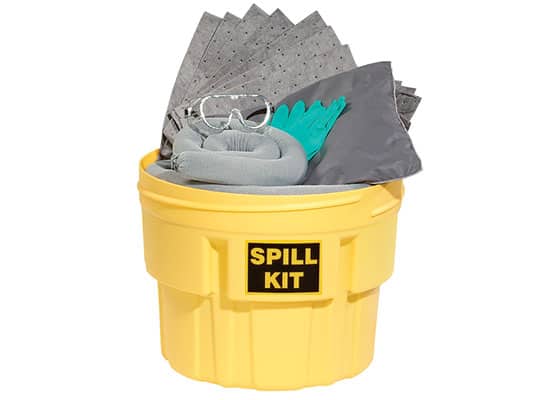Spill kits are an essential bit of equipment that are used to contain and clean up liquid spills.
Like first aid supplies, these handy tool kits are useful to have pretty much anywhere. From the workplace to public areas where a slippery floor can lead to accidents and injury.

Spill clean up kits are also extremely important to have in places where people work with potentially hazardous liquids – this includes labs, warehouses, hospitals, and even restaurant kitchens.
However, not all kits have the same things inside them and certain types contain specialized items. That’s because spill kit requirements depend on the environment that they will be used in, and the kinds of spills that they will potentially need to clean up.
Using the right type of spill kit is important.
If you’re unfamiliar with spill kits and want to make sure that you’re getting the right type (or if you’re just curious about what they contain), then don’t worry – we’ve got you covered.
In this guide, we’ll take you through everything a spill kit contains so you know what you’re getting.
We’ll also look at some different kinds of spill kits to help you learn the differences between them, and which kit is right for you!
What Is A Spill Kit?
As mentioned before, spill kits are a collection of absorbent materials and other supplies that are used to mop up and contain spills.
They aren’t the same as just a mop and a bucket – there are many different components in spill kits that make them capable of tackling all sorts of spills for emergency response. Including oil, chemical spills, and other hazardous liquids like an acid spill or body fluids.
In addition to regular cleaning tools, spill kits contain specialist spill clean up products along with protective equipment; additionally, a kit comes with its own bin to make disposing of the used materials much simpler and safer.
Spill kits come in several varieties, and these can contain different items depending on their intended purpose. However, most kits will contain similar things with a few changes for their specific application.
There are three main varieties of spill kits: general purpose universal spill kits, oil spill kits, and hazmat spill kits.
Kits also come in different sizes, depending on the site or volume of the spill. For example, small fleet spill kits that tuck inside a vehicle trunk or truck cab. All the way up to large mobile spill kits, and those than can handle spills from a 50 gallon drum.
We’ll take a closer look at each type soon, but first, let’s take a look at the most common items you’ll find inside a spill kit.
What Does a Spill Kit Contain?
While there are some differences between various types of spill kits, there are many things that stay the same between them.
All spill kits will typically contain the following cleanup materials:
Absorbent Pads
One of the most important items for dealing with liquid spills is a way to soak them up. Which is why absorbent pads are so useful to throw on top of spills.
Absorbent material pads are designed to soak up as much liquid as possible—without dripping—and contain it for disposal.
The type of absorbent pad depends on the specific spill kit you’re using, as not all pads work with every liquid (for example, dangerous chemicals need a chemical-resistant pad to mop them up safely).
This is indicated by the color of the absorbent pad, which is specific to the spill kit type.
Absorbent Socks
If you’ve ever seen a large spill in a store, then you might have seen absorbent socks being used to block the bottom of shelves.
These long, thin tubes are used as absorbent dikes for spill control. And are meant to keep liquids from traveling under hard-to-move surfaces or between rooms.
Like absorbent pads, they come in different colors specific to the spill response kit type.
Disposable Bags
When you’ve used up your cleaning materials, you need to dispose of them properly.
Just tossing them in a plastic bag and into the garbage isn’t safe (especially if the sorbent materials been used to mop up chemicals or biohazards like blood).
Therefore, specialty-marked disposable bags are included in spill kit contents so you’re able to safely get rid of clean up materials.
Safety Goggles
Wearing the right personal protective equipment (PPE) when dealing with spills is important. Safety goggles are required to protect your eyes from hazardous liquids and other materials.
They also keep your eyes safe from fumes, which is particularly important when dealing with spilled chemicals or other hazardous materials.
However, you should wear safety goggles for protection even when dealing with everyday spills.
Gloves
Like safety goggles, protective gloves are another important form of PPE while dealing with spills.
The type of gloves in a spill kit can differ based on what kind of spill you’ll be dealing with. But they’re usually some form of sturdy waterproof or nitrile glove that is intended to protect your hands against potentially dangerous liquids.
Disposal Container
Finally, you’ve got the actual container that the spill kit comes in. Typically, spill kit contents will come inside some kind of plastic bucket for storing items.
Not only is this handy for keeping the kit tidied away, but it also functions as a container for disposing of the used cleaning materials.
Other designs of spill kit containers include wheeled carts for easier transportation, or drum versions to carry more supplies.

Types Of Spill Kit
As mentioned earlier, there are some differences between the three primary kinds of spill kits.
It isn’t just the type and color of the absorbent that changes – there are also some additional things in each type of kit that make it more specialized for its intended job.
General Purpose Spill Kit
The general purpose, or universal spill kit, is the most common type of spill kit. That’s because they are suitable for mopping up most kinds of spills.
They contain the usual cleaning materials found in all spill kits and are designed for cleaning water-based spills as well as hydrocarbons.
The absorbents used in universal spill kits are gray, and they are capable of mopping up nearly all liquids including oils.
Oil Spill Kit
As the name suggests, oil spill kits are intended to clean up spilled hydrocarbons. Oil sorbent materials are colored white.
They are buoyant, so particularly effective at removing oil from the surface of water. Which is because they are hydrophobic (or repel water); letting them absorb oil without taking on water and sinking.
As such, they make an ideal spill kit for marine locations.
Chemical Spill Kit
Chemical spill kits are intended for use on hazardous materials, such as corrosive acids, and solvents.
These are dangerous materials to deal with, so using the right PPE and chemical resistant equipment is important to comply with OSHA regulations. As a result, many hazmat spill kits come with additional PPE such as a mask or perhaps even a respirator.
Absorbents in these kits are yellow and are made out of materials that will not react with any hazardous chemicals.
It’s important to take care when dealing with hazardous waste, so be sure to use the appropriate PPE and be careful to dispose of waste materials properly.
Specialty Kits
Lastly, specialty spill kit contents include items for handling specialized emergency spill response.
These types of kits have sorbents for spill containment and cleanup of specific fluids. Such as neutralizing agents for acid spills, or disinfectants for biohazards like blood.
In the case of mercury spills, items like a dustpan and brush are necessary to sweep up absorbent cleanup powder.
Final Thoughts
Spill kits are a great way to keep messes contained and under control.
As long as you have the right kind of spill clean up kit, you should be able to handle almost any situation without having to worry about ruining your floor or risking injury.
Using the appropriate kit will make sure that spills are sorted effectively.
So now you know a bit more about what spill control kits are, what they contain, and some differences between the types of spill kits.